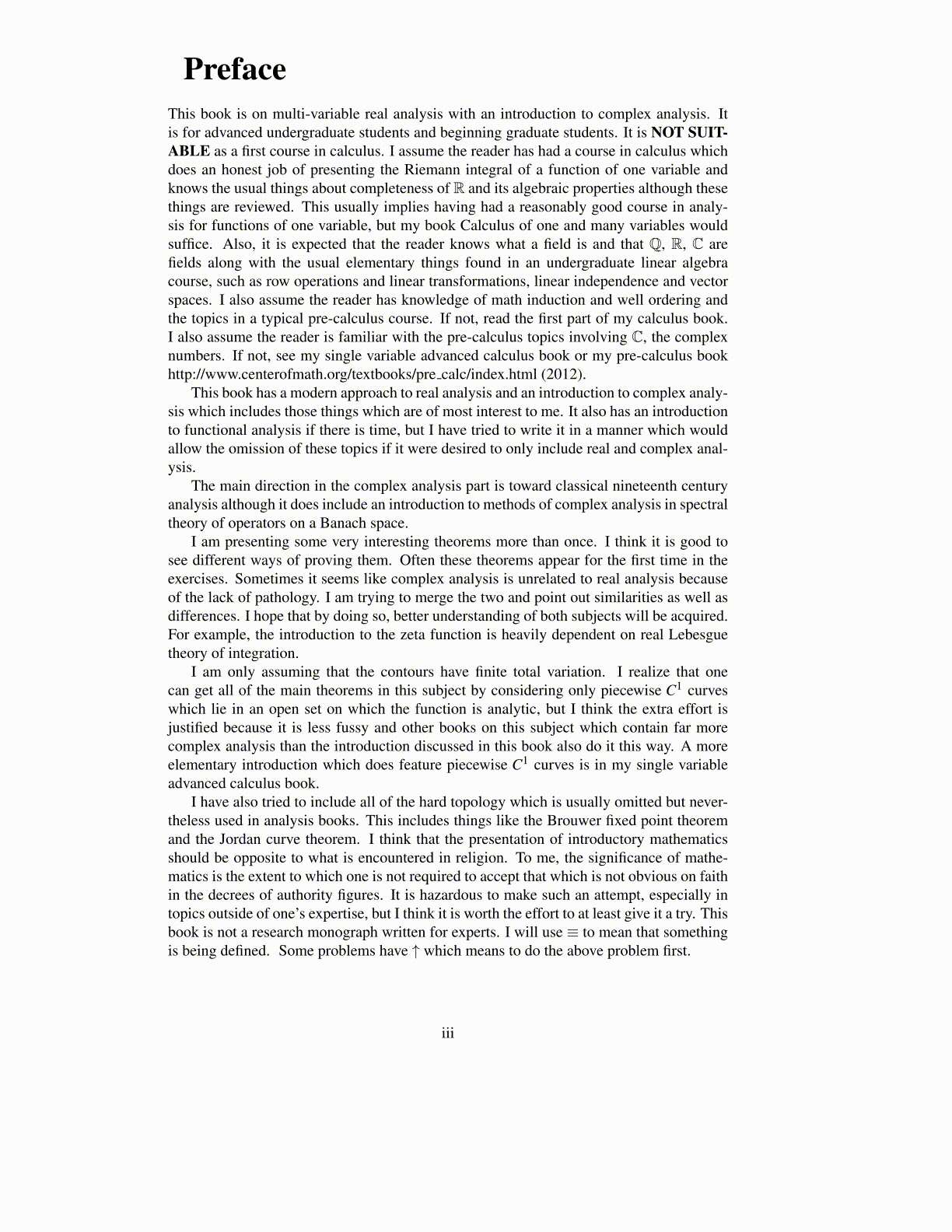
PrefaceThis book is on multi-variable real analysis with an introduction to complex analysis. Itis for advanced undergraduate students and beginning graduate students. It is NOT SUIT-ABLE as a first course in calculus. I assume the reader has had a course in calculus whichdoes an honest job of presenting the Riemann integral of a function of one variable andknows the usual things about completeness of R and its algebraic properties although thesethings are reviewed. This usually implies having had a reasonably good course in analy-sis for functions of one variable, but my book Calculus of one and many variables wouldsuffice. Also, it is expected that the reader knows what a field is and that Q, R, C arefields along with the usual elementary things found in an undergraduate linear algebracourse, such as row operations and linear transformations, linear independence and vectorspaces. I also assume the reader has knowledge of math induction and well ordering andthe topics in a typical pre-calculus course. If not, read the first part of my calculus book.I also assume the reader is familiar with the pre-calculus topics involving C, the complexnumbers. If not, see my single variable advanced calculus book or my pre-calculus bookhttp://www.centerofmath.org/textbooks/pre calc/index.html (2012).
This book has a modern approach to real analysis and an introduction to complex analy-sis which includes those things which are of most interest to me. It also has an introductionto functional analysis if there is time, but I have tried to write it in a manner which wouldallow the omission of these topics if it were desired to only include real and complex anal-ysis.
The main direction in the complex analysis part is toward classical nineteenth centuryanalysis although it does include an introduction to methods of complex analysis in spectraltheory of operators on a Banach space.
I am presenting some very interesting theorems more than once. I think it is good tosee different ways of proving them. Often these theorems appear for the first time in theexercises. Sometimes it seems like complex analysis is unrelated to real analysis becauseof the lack of pathology. I am trying to merge the two and point out similarities as well asdifferences. I hope that by doing so, better understanding of both subjects will be acquired.For example, the introduction to the zeta function is heavily dependent on real Lebesguetheory of integration.
I am only assuming that the contours have finite total variation. I realize that onecan get all of the main theorems in this subject by considering only piecewise C1 curveswhich lie in an open set on which the function is analytic, but I think the extra effort isjustified because it is less fussy and other books on this subject which contain far morecomplex analysis than the introduction discussed in this book also do it this way. A moreelementary introduction which does feature piecewise C1 curves is in my single variableadvanced calculus book.
I have also tried to include all of the hard topology which is usually omitted but never-theless used in analysis books. This includes things like the Brouwer fixed point theoremand the Jordan curve theorem. I think that the presentation of introductory mathematicsshould be opposite to what is encountered in religion. To me, the significance of mathe-matics is the extent to which one is not required to accept that which is not obvious on faithin the decrees of authority figures. It is hazardous to make such an attempt, especially intopics outside of one’s expertise, but I think it is worth the effort to at least give it a try. Thisbook is not a research monograph written for experts. I will use ≡ to mean that somethingis being defined. Some problems have ↑ which means to do the above problem first.
iii